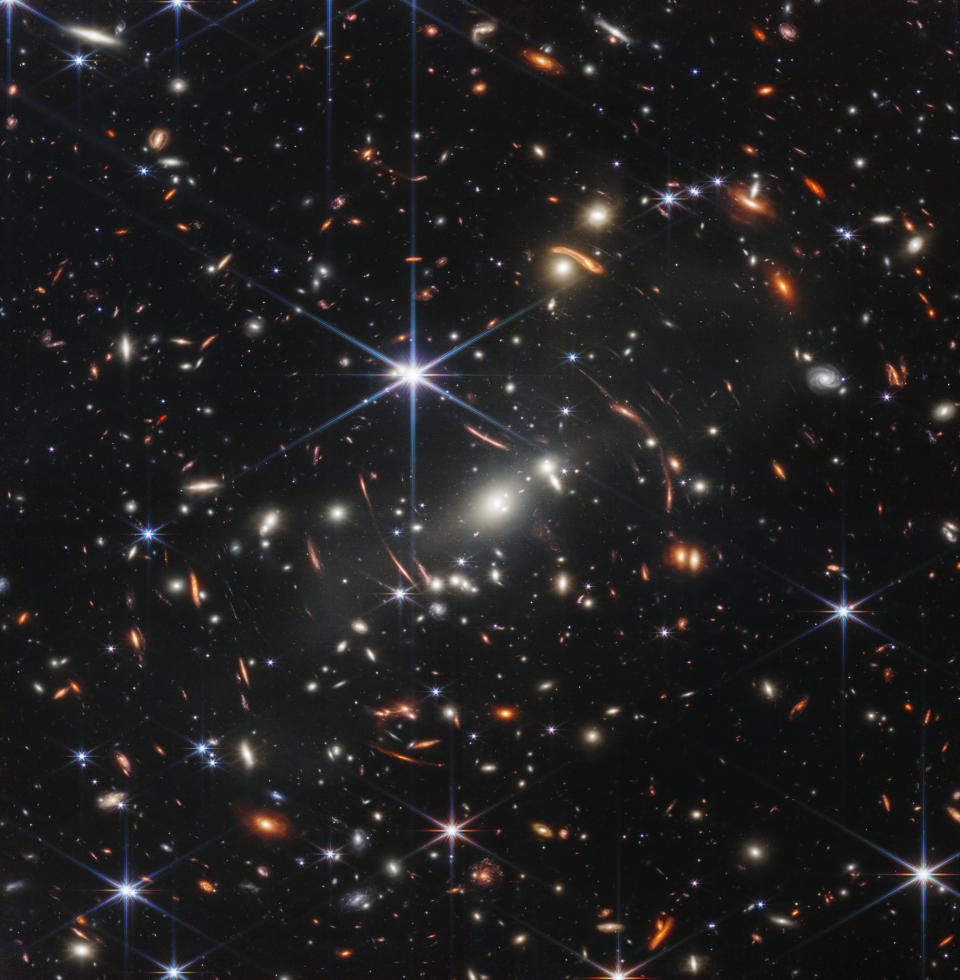When I sat down with Jane Rigby last month, in an upper-floor conference room at The Children’s Museum of Indianapolis — a quiet reprieve from the throngs of families perusing cosmic exhibits and dinosaur bones below — her eyes were warm and measured. She was also wearing a menagerie of gravitationally lensed galaxies.
Her T-shirt was decorated with illuminated realms warped by massive structures in their vicinity, stretched and squashed like taffy thanks to gravitational tides that twist the very fabric of spacetime as though it were a bendable sea of four-dimensional rubber. This image was actually among the first stills captured by the James Webb Space Telescope, a gold-plated, multibillion-dollar instrument located a million miles from Earth — a machine for which Rigby serves as the chief scientist, and for which she just earned the White House’s 2024 Presidential Medal of Freedom.
It is scenes such as this quarry of manipulated galaxies that Rigby manages to help bring down to Earth with the rest of the JWST team, both metaphorically and literally speaking. Images constructed with this telescope have allowed scientists to deepen their nuanced research, encouraged journalists to muse endlessly in their stories and indeed inspired designers to craft thought-provoking pieces that encapsulate concepts once confined to fiction. They’ve changed how we see the universe, and how we mentally place ourselves within.
Related: NASA selects new head of science for the James Webb Space Telescope
“I work on a telescope that does the impossible,” Rigby said following her acceptance of the medal. “We are measuring planets and the distant universe in ways that were just impossible.”
Ever since its exquisite launch sequence to space early on Christmas morning in 2021, the James Webb Space Telescope has been a vision. With a toolkit of highly sensitive infrared spectrometers and cameras, it’s able to detect wavelengths of light from deep space that have elongated over time like strung-out rubber bands.
They’re wavelengths that appear shifted from our perspective, having gone from the blue end of the electromagnetic spectrum to the red end. It’s like they have been pulled upon as the universe has continuously expanded over the last several billions of years, and in fact continues to do so. Eventually, such shifting wavelengths tread into infrared waters, unseeable by not just the human eye, but nearly all human telescopes — yet importantly, these signals represent objects that have physically shifted away from us in tandem with their color classification. Redshifted wavelengths hold data about mysterious pieces of the universe that existed when the cosmos was a smaller kind of infinity than the one we live in today. And the James Webb Space Telescope can understand that data.
It can translate it into portraits with enough power to revolutionize science and provoke reminders of the wondrous world we inhabit. It’s how scientists were able to image a record-breakingly old galaxy named for the discoverer’s daughter, Maisie, access new crevices of a coffee-hued nebula, study an exoplanetary system that looks awfully like our own and reinvigorate debates like one about how quickly our universe really is ballooning outward.
“We go through our lives all the time, in the middle of amazement, but we’re not conscious of it,” Rigby told Space.com. “We’re getting snapped between the profound and the mundane all the time.”
Rigby recalls when she’d seen the the very first of the telescope’s deep space images. “I was one of the first people to see those data,” she said. “We were all in a room, it looked like a conference room like this, and we all got to look at it at the same time.”
The team eventually decided, however, that they needed to get even deeper into the cosmos with the JWST’s infrared powers. They wanted to punch even further back in time. So, they got some procedures going. That ran overnight. The next day, Rigby’s parents were visiting, and she was preoccupied with things like making sure her guest room was ready to go.
“I’ve got to make breakfast and there’s got to be waffles,” she said of her thought process. “Then I went upstairs, still in my pajamas, and downloaded …. and there it is.”

Not only was what she saw beautiful, but for a portion of time, it felt like that data was for her eyes specifically. “That was an amazing feeling,” Rigby explained. “That, ‘oh my gosh, we built this thing and it works. It works really well.'” But then, it was time to share the excitement.
“As the chief scientist, one of the things that’s brought me the most joy has been watching that glee in the scientific community,” she said. “I want to show everyone that it’s so beautiful, and also that, ‘Yes! we pointed at the right object!'”
Throughout her career, Rigby has worked with quite a few incredibly impactful telescopes including the Hubble Space Telescope, Spitzer, the Keck Telescopes and the Chandra X-ray Telescope, the latter of which is actually making headlines in the astronomy community right now due to a present state of budgetary limbo. She’s published over 150 papers about her discoveries, has both masters and doctoral degrees in astronomy from the University of Arizona, and is passionate about social activism. And now, she’s earned the White House’s highest civilian honor alongside 18 other accomplished recipients.
“The Presidential Medal of Freedom,” according to the White House website, “is the Nation’s highest civilian honor, presented to individuals who have made exemplary contributions to the prosperity, values, or security of the United States, world peace, or other significant societal, public or private endeavors.”
I suppose it can also be argued that the James Webb Space Telescope’s impact transcends the seemingly unending differences that plague humans. This telescope can be imagined as a symbol of peace, in its own way.


In her post-award speech, Rigby drew attention to previous Medal of Freedom award winners, too, including astronaut Sally Ride, politician Harvey Milk, and social activist Bayard Rustin, one of whom was the first American woman in space and two of whom were proud advocates of topics like gay rights, civil rights and nonviolence: “I wouldn’t be here if not for them.”
And strikingly, her enthusiasm for science also radiates beyond her prestigious academic achievement. A major part of her scientific contribution surrounds diligently working to expand scientific discussion such that anyone can offer an opinion, or at the very least, marvel in the beauty of space for a moment or two. Just prior to our interview, in fact, she’d wrapped up a long presentation at the museum. It was for a collection of dreamy-eyed children sitting like pretzels on the floor with impressive questions regarding stellar death mechanisms and dark matter distribution.
Science isn’t just about the numbers, she emphasizes — though, as a self-proclaimed empiricist foremost, she does admit her love of the numbers. It’s also about the immutable reality that, by nature of being human, we can’t escape our humanity.
Related Stories:
— James Webb Space Telescope suggests supermassive black holes grew from heavy cosmic ‘seeds’
— This diamond exoplanet lost its atmosphere — then it grew another
— James Webb Space Telescope finds ‘extremely red’ supermassive black hole growing in the early universe
“All the time we go back and forth between the profundity of about-millions-of-solar-mass black holes from when the universe was just a couple of 100 million years old,” she said. “And then we’re talking about personality conflicts; about how these two people can’t agree about who gets to be the first author.”
“We can get along better, we can be more interested, we can have better practices,” she said. “But science is a human endeavor done by humans.”
Of course, behind the JWST’s success lies a stunning group of humans: engineers, scientists, press officers, program coordinators, factory workers and far more that you’ll find along the supply-chain path. “I’m a very collaborative scientist,” Rigby said. “My most fun time is when I get on my science collaboration every Tuesday, and we get on the Zoom and we have some data. It’s like unboxing on YouTube.
“It’s like a holiday.”

Dr. Sarah Adams is a scientist and science communicator who makes complex topics accessible to all. Her articles explore breakthroughs in various scientific disciplines, from space exploration to cutting-edge research.








